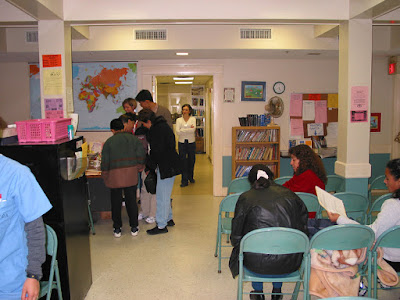 |
| Apartments in refugee neighborhood |
 |
| Cambodian children - cold in the apartments |
The way it worked was I would take clinical groups of community
health nursing students into refugee communities. There were nearly always 8
students/group, so initially we had 4 teams of 2 students and me. Later as our
reputation spread, we had volunteer and then paid translators and community
health workers, like promotoras de salud.
Still later in the process we developed clinics with medical (primary care,
psychiatry, gynecology, pediatrics, etc.) and other services, which were integrated
into the district health scene. But for now, I’ll describe the straight
district health end of things.
We started in one apartment building (about 40 units),
where a lot of refugees lived (as well as other poor people). We went door to
door, finding health and related problems. On the first day, two of students
helped deliver a baby – so we knew things were going to be interesting. Every
time we’d find a problem, one of the student teams would stop to help the
people solve the problem. Some problems were straightforward and readily solved,
some took semesters to solve, and some were never completely solved. Often, one
thing would lead to another and we’d work with the people over time. And Leslie
was working with us (what an education for students that was!). It was never, ever about referral. It was always about
helping the most underserved people be served – solving problems (pregnancy, primary care, depression, hunger, family violence, cancer, and on and on and on).
In the day we sweat
it out in the streets
of a runaway
American dream
 |
| Community garden outreach |
 |
| Agape Clinic waiting room |
When we got through the first building, we left a team in
that building to continue working through problems and went through the same
process in the next building. Then we left another team in the second building
and started working through the third. And so on. Over time, over semesters we had all the buildings covered in about an 8 block
area (which was a lot). And we also had classes and other outreach (health
screening, vaccinations, etc.) going on in schools, churches, and community
gathering places; for awhile we were doing intake assessments for children who had
been removed from their homes because of abuse; and we added the medical, etc. and
expanded clinic hours.
 |
| Estevan Garcia, MD and Charles Kemp, FNP |
Much of what we accomplished was through partnerships and
cooperative relationships with community organizations, from grass-roots groups
like the Association for Salvation of Cambodian Refugees to Parkland Memorial
Hospital, Dallas County Health Department, National Council of Jewish Women, Dallas
Police, and a number of foundations, churches, and religious organizations - and of course, the Agape Clinic.
We said we would take responsibility for this community
and we did that. Far out vision, isn’t it. With dignity and justice for all in
the real world. What an education for students it all was!
It lasted in one form or another for about 30 years and parts of
it (East Dallas Health Center, Agape Clinic) continue through today
and are seeing more patients now than
ever before.
 |
| Refugee children on Carroll Street |
---------------
We didn't have a TV in the waiting room. Instead we had books - especially children's books and a children's play area.

No comments:
Post a Comment